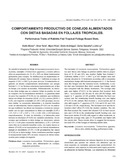| dc.rights.license | http://creativecommons.org/licenses/by-nc-sa/3.0/ve/ | |
| dc.contributor.author | Nieves, Duilio | |
| dc.contributor.author | Terán, Omar | |
| dc.contributor.author | Vivas, Mayra | |
| dc.contributor.author | Arciniegas, Gloria | |
| dc.contributor.author | González, Carlos | |
| dc.contributor.author | Ly, Julio | |
| dc.date.accessioned | 2009-05-12T22:04:45Z | |
| dc.date.available | 2009-05-12T22:04:45Z | |
| dc.date.issued | 2009-05-12T22:04:45Z | |
| dc.identifier.issn | 0798-2259 | es_VE |
| dc.identifier.uri | http://www.saber.ula.ve/handle/123456789/28223 | |
| dc.description.abstract | Se estudió la inclusión de follaje de leucaena (Leucaena leucocephala), naranjillo (Trichanchera gigantea) y morera (Morus
alba) en proporciones de 10; 20 y 30% en dietas balanceadas granuladas para conejos. Se distribuyeron en alojamientos individuales 80 conejos Nueva Zelanda × California en etapa de engorde (1124,1 ± 289,7 g de peso vivo) en 10 tratamientos siguiendo un diseño completamente aleatrorizado con arreglo factorial 3 × 3, los factores estuvieron representados por el tipo de forraje y los niveles de inclusión. Adicionalmente, se formuló una dieta testigo que no contenía follaje de prueba, la cual se comparó con los tratamientos dietéticos. La ganancia diaria de peso fue superior (P<0,05) en los animales que recibieron dietas con follaje de leucaena (29,49 ± 6,10) y morera (26,00 ± 6,20), con respecto a naranjillo (21,85 ± 5,62 g/conejo); de manera similar, la conversión alimenticia y la relación beneficio costo de alimentación, fueron mejores (P<0,01) en los animales que recibieron las dietas con leucaena y morera en comparación con los que consumieron la dieta con naranjillo (4,45 ± 1,41; 5,01 ± 1,57 y 5,97 ± 1,74; y 3,28; 2,82 y 2,63 bolívares, respectivamente). El nivel de inclusión y la interacción entre factores no afectaron (P>0,05) las variables estudiadas. En los conejos que recibieron la dieta testigo se observaron valores de 4,21 ± 0,94 para conversión alimenticia y 2,76 ± 0,59 bolívares (Bs) en la relación beneficio
costo, los cuales fueron similares (P>0,05) a los encontrados en los demás tratamientos, aunque el crecimiento (31,78 ± 4,54 g/conejo/día) fue mayor (P<0,05) en la dieta testigo. Estos resultados permiten sugerir la incorporación hasta 30% de estos recursos en dietas balanceadas para conejos de engorde. | es_VE |
| dc.language.iso | es | es_VE |
| dc.rights | info:eu-repo/semantics/openAccess | |
| dc.subject | Leucaena leucocephala | es_VE |
| dc.subject | Trichanchera gigantea | es_VE |
| dc.subject | Morus alba | es_VE |
| dc.subject | Alimentación de conejos | es_VE |
| dc.subject | Respuesta productiva | es_VE |
| dc.title | Comportamiento productivo de conejos alimentados con dietas basadas en follajes tropicales | es_VE |
| dc.title.alternative | Performance traits of rabbits fed tropical foliage based diets | es_VE |
| dc.type | info:eu-repo/semantics/article | |
| dc.description.abstract1 | The inclusion of Leucaena leucocephala, Trichanchera gigantea and Morus alba foliage in pelleted rabbits diets in proportions of 10, 20 and 30% was studied. Eighty New Zealand × California rabbits (1124.1 ± 289.7 g of live weight) were individually allocated in 10 treatments according with a completely randomized design with factorial arrangement 3 × 3, the factors were the forages and the inclusion levels. Additionally, a control diet was formulated that didn’t contain test
foliage, which was compared with the dietary treatments. The average daily gain was higher (P<0.01) in the animals that received diets with L. leucocephala (29.49) and M. alba (26.00) foliage, with regard to T. gigantea (21.85 g/rabbit). Similarly the feed conversion and the relationship benefit feeding cost was higher (P<0.01) in the animals that received L. leucocephala and M. alba with regard to T. gigantea (4.75, 5.34 and 6.30, and 3.28, 2.82 and 2.63 Bs, respectively). The inclusion level and the interaction didn’t affect (P>0.05) the studied variables. The rabbits that received the control diet showed 4.21 in feed conversion and 2.76 Bs in the relationship benefit feeding cost, and there were similar (P>0.05) with regard to other treatments; although the average daily gain (31.78 g/rabbit) was higher with the control diet. These results allow to suggest the incorporation until 30% of this forages in fattening rabbits diets. | es_VE |
| dc.description.colacion | 173-180 | es_VE |
| dc.description.email | dnieves@cantv.net | es_VE |
| dc.description.frecuencia | Bimestral | es_VE |
| dc.identifier.depositolegal | 199102ZU46 | es_VE |
| dc.subject.institucion | Universidad del Zulia (LUZ) | es_VE |
| dc.subject.institucion | Universidad de Los Andes (ULA) | es_VE |
| dc.subject.keywords | Leucaena leucocephala | es_VE |
| dc.subject.keywords | Trichanchera gigantea | es_VE |
| dc.subject.keywords | Morus alba | es_VE |
| dc.subject.keywords | Rabbits feeding | es_VE |
| dc.subject.keywords | Performance traits | es_VE |
| dc.subject.publicacionelectronica | Revista Científica | es_VE |
| dc.subject.seccion | Revista Científica: Medicina Veterinaria | es_VE |
| dc.subject.thematiccategory | Medio Ambiente | es_VE |
| dc.subject.tipo | Revistas | es_VE |
| dc.type.media | Texto | es_VE |



